Musings
<
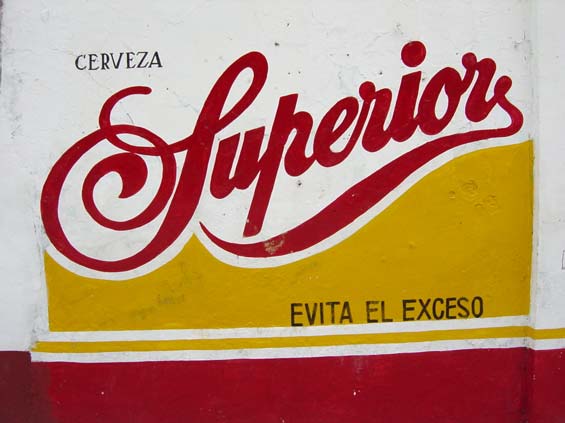
Wall-sign frequently seen across Mexico, but it’s not a national mantra. Avoid excess! Yeah, right.
Today, after I got in a modest increase to the word count by 8:30 am, we played hooky and scooted up to Neel’s Gap to head east/right/toward Maine on the AT, not walking it ’cause it was the AT, but ’cause it was easy access and a good, shady route for a hot day.
No doubt about it, the highlight of the trip was Sr. No-Shoulders, stretched across the path, on the move. Never saw his head, but saw the rest of him from not far below. Down at the end of his tail? About eight buttons. I give him about three feet, at least 32-33 inches. Coloration? Dark, almost black towards the tail, but diamondy closer to the head. Overall, darker rather than sandier. His Linnean name? I’m not sure. Crotalus spp. for sure, but Crotalus horridus (Timber or Canebrake) or C. adamanteus (Eastern Diamondback)? I’ll have to ask F&D….
BTW, No-Shoulders is the generic name for snakes I learned from country people living inland on the South Carolina coastal plain, way back in the 80s when I was working near St. Stephens. I always thought the term extremely evocative. I learned it when well-meaning heavily-accented fisherman kept screaming at me as I was sitting in the water at the edge of a reservoir (water-screening soil samples, of course), and a sinuous beastie, a cottonmouth as I recall, was swimming toward me and my tripod, curious I’m sure, rather than hungry.
Posted at 10:22 PM |
Comments Off on No-Shoulders

Dogs. Cats. More dogs. More cats. Didn’t go by the house with the parakeet in the window. Yet, today’s walk followed the ruta mascota. [In all fairness, the (nascent) cabbage is no mascota.]
Also, squirrels. Mockingbirds. A robin or two. A cardinal. More squirrels. Busy morning here in Virginia-Highland!
By the way, today’s title is a polite homage to tourist materials from the Yucatán, aka the Maya Riviera, where you’re invited to visit the Ruta Maya.
Posted at 8:32 PM |
Comments Off on Ruta mascota

Morning mist rising on Lake Clara Meer.
In 1377, a North African we know as Ibn Khaldûn (much longer Arab name) began a seven-volume history of the world, named (in translation) Book of Lessons and Archive of Early and Subsequent History, Dealing with Political Events Concerning Arabs, Non-Arabs, and Berbers, and with Their Contemporary Supreme Rulers. Ibn Khaldûn, born in 1332 in what is now Tunis in North Africa, did a superb job of describing the world he lived in, and perhaps more remarkably, modeled its dynamism. He believed the most prominent source of sociopolitical power lay in a society’s approach to group solidarity and collective action, so that the few who marshaled it better became the leaders, achieved prominence, and were able to establish dynasties. Then, Ibn Khaldûn wrote, “the dynasty collects the property of the subjects and spends it on its inner circle and on the men connected with it who are more influential by reason of their position than by reason of their property.�? Thus, “dynasty and government are the world’s market-place. All kinds of merchandise are found in the market and near it�? (Franz Rosenthal translation, 2005 Princeton University Press edition).
Clearly, the marketplace, or economics, are critical to the formation and functioning of societies. How to explain? And do it in a readable fashion…. This is what I was pondering as I held my mouth the right degree of open for the dental hygienist today….
Posted at 5:52 PM |
2 Comments »
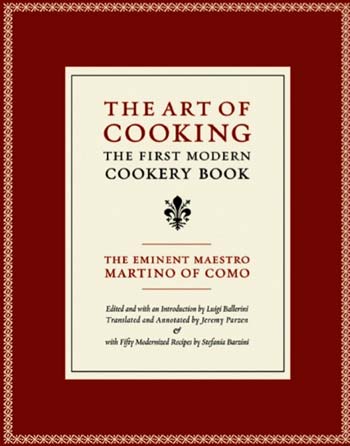
In normal life, “simplicity�? is synonymous with “easy to do,�? but when a chef uses the word it means “take a lifetime to learn.�?
—observes Bill Buford in Heat: An Amateur’s Adventures as Kitchen Slave, Line Cook, Pasta-Maker, and Apprentice to a Dante-Quoting Butcher in Tuscany (2006; Alfred A. Knopf). I’ve gotten through the line cook part so far….
I find it endlessly (well, almost) interesting how specialized vocabulary plays out, even when those in the know are a relatively small group. In archaeological field work, “check out�? is a simple phrase—be forewarned by the above definition, ’cause checking out a landform is a very complex activity, if done superbly, and requires an awareness of myriad situational factors, for example, post-depositional land use effects, distance to the nearest surface water source, where neighboring occupations were, what the soil’s like—I could go on (but Buford’s more interesting).
Buford sandwiches tales of culinary and gastronomic events, both on this side of the Atlantic and overseas, between the subtitled sections. While in Italy prior to the pasta-making, Buford discusses a treatise that’s more than a cookbook by a Vatican librarian who visited a gourmand Cardinal in his summer retreat outside of Rome in 1463. The librarian, Platina, was no chef, and recorded the recipes and observations of his host’s chef, the Maestro. Platina includes bits of received wisdom—here’s one of the best:
…�?the testicles of younger animals are considered better for you than those of old animals,�? except the testicles of roosters, whose testicles are good for you regardless of the age of the bird, especially if served alongside calves’ feet and spices, in the Roman style.
I await the latest in Science or Nature on this! In the meantime, you can get an English translation of Platina’s book from Amazon for about $20!
For now, thanks for “checking out�? my blahg!
Posted at 4:15 PM |
Comments Off on Kitchen tales

Peer-reviews and book publication paradigms are shifting. Nature has announced an online peer-review process, which itself is under discussion online! They ask:
What is the best method of peer review? Is it truly a value-adding process? What are the ethical concerns? And how can new technology be used to improve traditional models?
Yale University Press is even letting the author of one of its titles post a PDF of the book on his own web page for download. The professor: Yochai Benkler, Yale University Law School. The title: The Wealth of Networks: How Social Production Transforms Markets and Freedom.
Without a doubt, the internet and associated technologies like standard file types facilitate exchanges at scales never before possible. I’m loving seeing traditional institutions incorporating new capabilities into their workflows and distribution networks. If I had another beer, I’d probably argue that such shifts are the root of changes we most love to talk about in anthropology!
And the illustration?—statues and roads of Rapa Nui (known back in the old days as Easter Island), showing routes emanating from a quarry in the eastern part of the island published by Carl Lipo and Terry Hunt. Yellow-dot statues (those huge ones) are scattered around the island.
Posted at 5:17 PM |
Comments Off on Institutional evolution
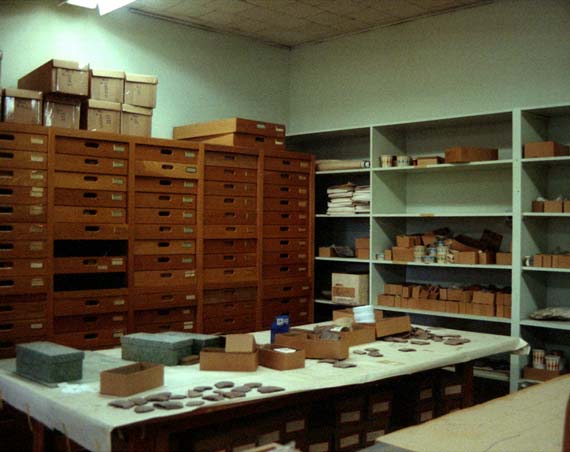

John’s been periodically scanning old slides and dumping the images into iPhoto, for my delectation and for archiving, and I today I poked around and found this picture of the long-time Archaeology Lab from the second floor of Baldwin Hall (yes, at UGA). The lab was eradicated when the cultural hegemony decided that an ecological focus to the Anthro Department was new, hip, and the way to go. Their supreme ignorance was that the archaeologists had been doing this since, oh, at least the 1950s, and way before if you count Kroeber, never mind that the department was established by archaeologists!
This is also by way of mentioning a new blahg by Mouse, who’s in the midst of Freshman finals (I think), supervised by Emily the goose. She (they?) has had several recent interesting anthropological observations, and I missed commenting on one of the best recently when I was in impoverished wifi conditions while in temporary residence in rural Ingham County.
Sorry I can’t get the caption to work for the modified Google Earth image I found on the web: thought it’s pretty darned neat! Here’s where it came from….
Posted at 5:39 PM |
1 Comment »
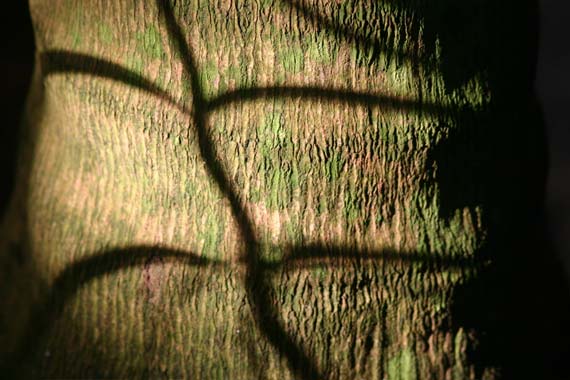
Light in the ABG’s conservatory can be, ahem, illuminating!
John and I have been deliberating about when to re-up our ABG membership, since we don’t spend much time there this time of the year and it expired the end of May. I guess we’ll wait until fall, when the plants and our time will better conspire to get us in. I still get their email updates, however, to my clandestine Yahoo address (the better to filter junque mail, you know!), so I know that there’s currently an exhibit of Niki de Saint Phalle’s rounded, colorful sculptures festooning the grounds.
Posted at 2:53 PM |
Comments Off on Tree torso

Iris next to the Botanist’s raspberry patch and grape fence at dusk.
I spent most of today wrapped up in household production and Mesoamerican political economy, with the exception of a lovely two-hour six-mile walk John and I took through vendors setting up for Summerfest, Piedmont Park, and the Saturday organic market by Alon’s in the glorious morning coolness ushered in by last night’s rain.
Posted at 5:57 PM |
Comments Off on Stunning iris

For Mom’s birthday last week, I made my first Key Lime Pie, and it came out perfectly. I love them rather tart, and this recipe, with both the juice and zest, nails the flavor. The tiny green zest bits give the filling an interesting green-dotted yellow color that may put off some diners (not at my table!), so cover it up with whipped cream!
———
Key Lime Pie
Use key limes or Mexican limones for best flavor. This is a classic recipe. The multiple teaspoons of zest really make it exceptional, but only for palates desirous of sharp citrus flavors trumping the sweetness.
This is a morning or next-day recipe, so it has time to cool thoroughly in the refrigerator.
It’ll take a while to do the squeezing and zesting, so do it first. Then preheat oven to 350°F.
Crust:
- 1 1/2 cups graham cracker crumbs (less than one pack)
- 2 tablespoons sugar
- 5 tablespoons unsalted butter, melted
Use food processor to turn crackers into crumbs, and mix crumbs with sugar. You can use cinnamon-and-sugar topped grahams for a subtle change in the crust flavor, but decrease the sugar by a teaspoon so the crust doesn’t fuse. Add the melted butter (microwave makes melting easy) and mix to thoroughly incorporated dry ingredients, then press into 9-inch pie plate (glass is best).
Pop into oven and bake for 10 to 12 minutes until slightly browned. Remove, leaving oven on.
Filling:
- 1 13-14 oz. can sweetened condensed milk, can be no-fat
- 4 egg yokes, large
- 1/2 cup key lime juice
- 2-4 teaspoons key lime zest, finely grated
Begin by whisking milk and yokes together (by hand is fine). Then add juice and zest, whisking until the mixture is homogeneous. It will thicken a bit as the juice reacts.
Pour into graham crust (doesn’t have to be cooled), and bake about 15 minutes until filling is set, although center can be slightly jiggly.
Cool at least 4 hours or overnight. You can top it with meringue (using up the egg whites), whipped cream, or eat it plain. Otherwise, use leftover egg whites in scrambled eggs or another dish.
Posted at 4:13 PM |
2 Comments »
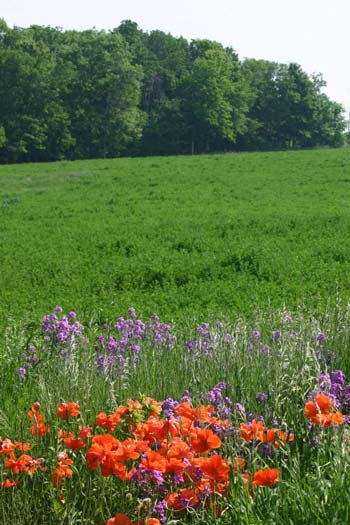
Last week was just about the perfect time to visit southern Michigan, except for the heat, as it was in the throes of the green season. Recent rain changed the palette and brought the verdancy nearly to its peak. John and I walked along Sycamore Creek, and the woods floor was damp and smelled of the best of shadiness, as the canopy leaves are full out. In the spots where we came out into old fields we found happy spring growth, unfortunately especially of PI (my friend and yours: poison ivy).
Here you can see the typical Michigan non-winter landscape mosaic of field and forest, sewn together by fencelines—with or without fences—sometimes with exotic species, like these flowers, that make dramatic visual borders.
Do not expect it to look quite like this in Ohio, BTW, as down there they pretty much plow right up to the blacktop, unless there are steep drainage ditches. Either way, colorful fencelines are absent.
Posted at 5:09 PM |
Comments Off on Green scenes










